Key takeaways:
- Selective mutism is often mistaken for shyness, but it deeply involves anxiety, particularly in social situations.
- Finding one’s voice is essential for self-expression, fostering connections, and boosting self-confidence.
- Common signs of selective mutism include engagement in safe environments, avoidance of eye contact, and physical signs of distress during social interactions.
- Support systems, including family, peers, and professional guidance, are crucial for overcoming selective mutism and building communication skills.
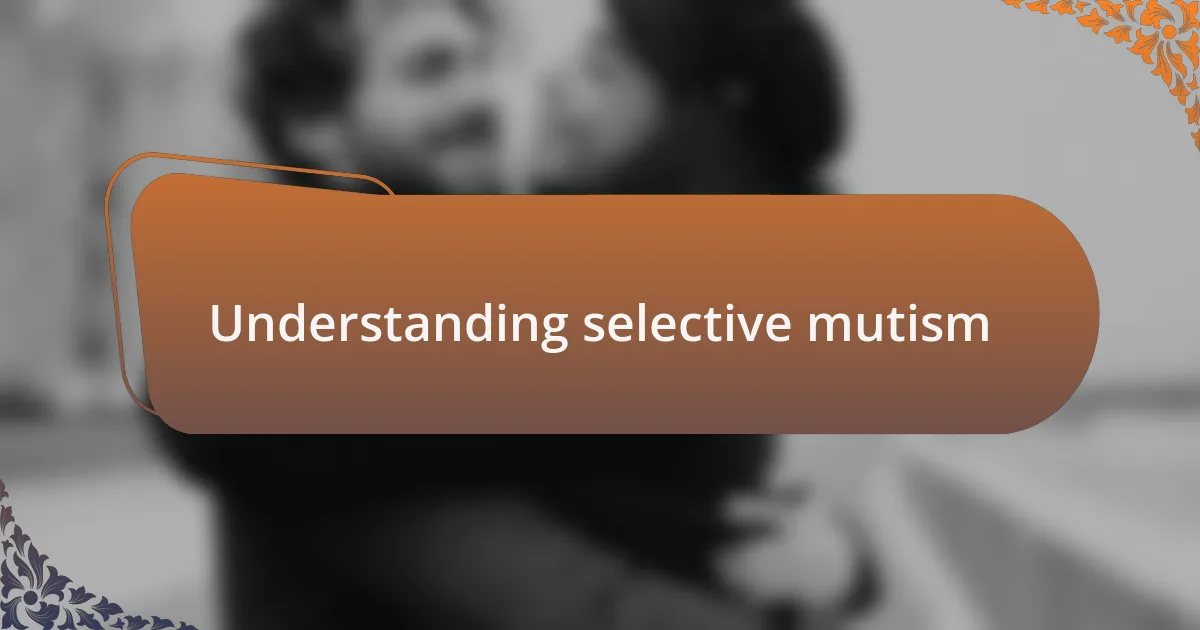
Understanding selective mutism
Selective mutism is often misunderstood as mere shyness, but it goes deeper than that. From my experience, it can feel like being trapped in a bubble where the words you want to say are just out of reach. Have you ever stood in a crowd, wanting to join in but feeling completely isolated? That’s a glimpse into the daily struggle many face with this condition.
It’s important to realize that selective mutism is not a reflection of someone’s willingness to communicate. I remember a moment where I found myself in the classroom, bursting with thoughts but unable to let them escape my lips. The internal turmoil can be overwhelming, leading to feelings of frustration and helplessness. How often do we underestimate the silent battles that many endure?
The roots of selective mutism often intertwine with anxiety, particularly social anxiety. I’ve seen firsthand how a simple situation, such as talking to a teacher or making friends, can trigger a wave of fear that silences even the most eager of participants. Why is it that some environments feel so much safer than others? It often boils down to comfort and familiarity, which can be crucial in understanding this complex condition.
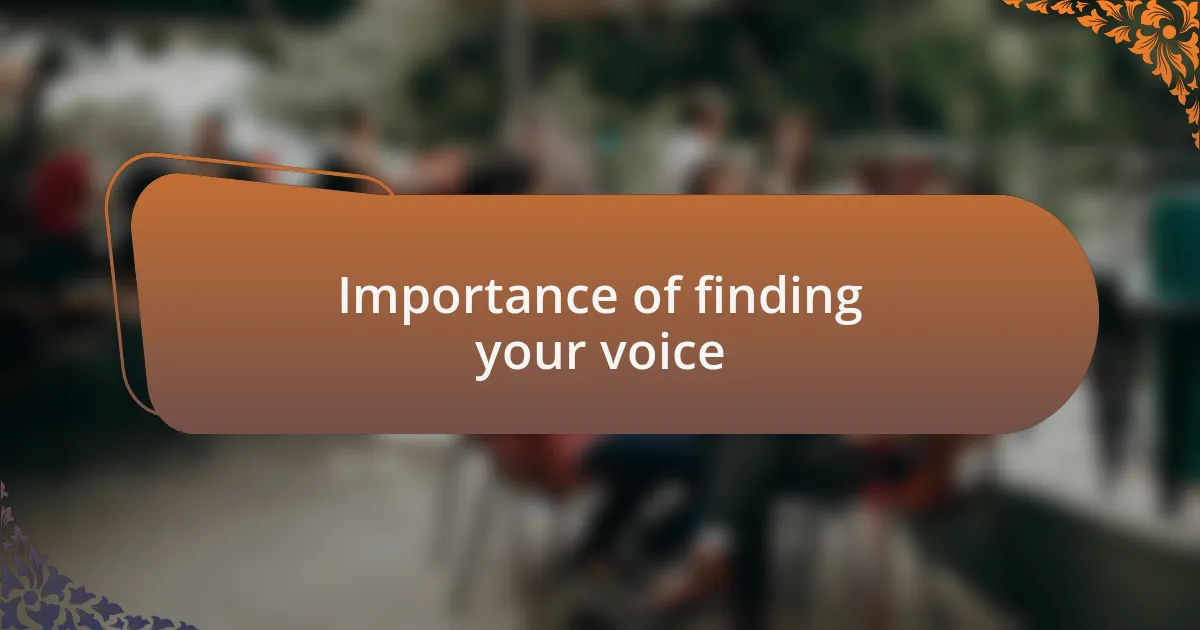
Importance of finding your voice
Finding your voice is vital because it allows you to express who you truly are. I recall the first time I spoke up during a group project; it felt like I had finally allowed a part of myself to emerge after being hidden for so long. That moment resonated with me deeply – every voice matters, and discovering yours can pave the way for genuine connection.
Not being able to communicate can lead to feelings of frustration and isolation. I remember feeling a wave of relief when I finally told a friend how much I struggled to speak in certain situations. It was liberating; sharing my experience was the key to unlocking deeper friendships. Have you ever experienced the power of sharing your truth? It’s remarkable how your voice can both empower you and resonate with others who might feel the same.
Moreover, finding your voice boosts self-confidence and fosters personal growth. When I started participating in discussions, I began to see myself in a new light, as someone with valuable insights to share. Each small victory added up, showing me that the fear of speaking was far less daunting than the benefits of being heard. Isn’t it worth pursuing the journey to find your own voice?
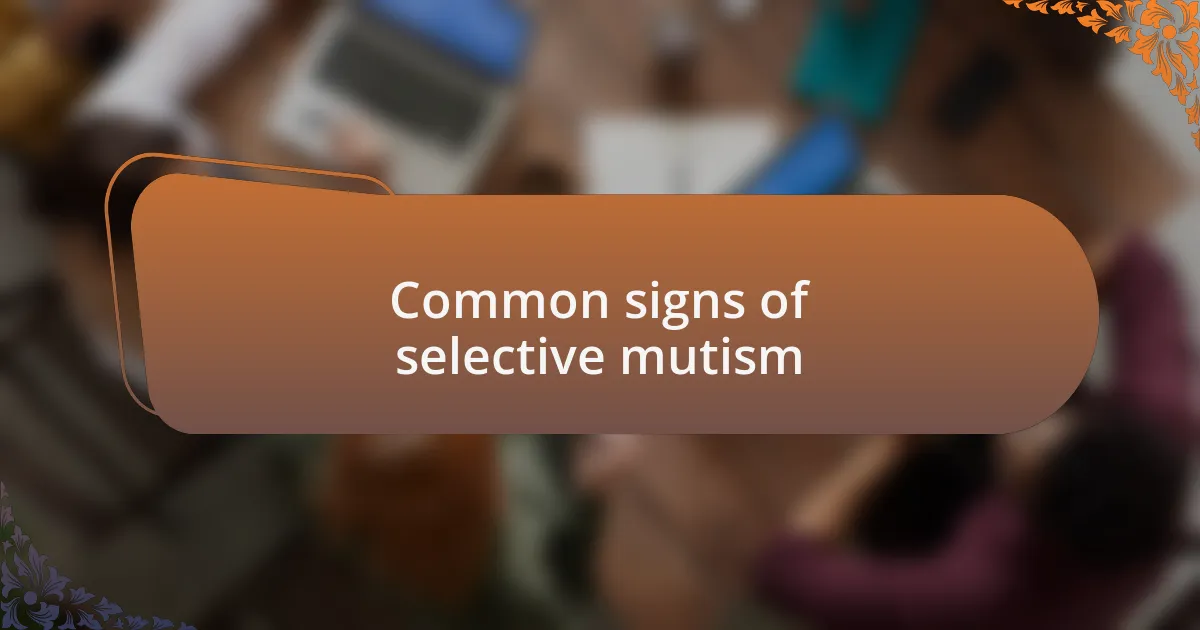
Common signs of selective mutism
Common signs of selective mutism often manifest in a child’s behavior, particularly during social interactions. For example, I once noticed a child who would engage enthusiastically at home but clammed up entirely in the classroom, almost as if a switch flipped. Have you ever seen someone who blooms in one environment yet shrinks in another? It’s a striking contrast that underscores the struggle they face.
Another sign is the avoidance of eye contact with peers or adults. I vividly remember the discomfort in a friend’s eyes when she was asked a question at a gathering; it was clear she wanted to respond but felt trapped in silence. This reluctance can stem from intense anxiety, making everyday social situations feel overwhelmingly risky.
Physical symptoms can also accompany selective mutism, such as fidgeting or showing signs of distress when expected to speak. I recall meeting a young girl who would cover her mouth in social settings, her body language screaming that she wanted to say something but felt utterly paralyzed. Can you imagine feeling that way in every group situation? It’s a poignant reminder of how deeply this condition can impact a person’s daily life.

Strategies for effective communication
Finding ways to communicate effectively can be challenging for someone experiencing selective mutism. I recall sitting in a coffee shop with a friend who often struggled to speak up in social settings. She found that using a notepad to write down her thoughts helped ease her anxiety, allowing her to express what she wanted to say without the pressure of speaking aloud. Have you ever tried jotting down your ideas before sharing them? It can feel liberating to have your thoughts written out.
Another strategy that I found helpful is creating a safe communication environment. I remember volunteering at a summer camp where we encouraged kids to communicate through art. One shy girl opened up by drawing her feelings instead of speaking, transforming her silence into vibrant colors and shapes. Fostering an atmosphere where non-verbal expressions are welcomed can make a world of difference. Can you see how allowing different forms of communication can empower those who feel silenced?
Additionally, establishing a routine can greatly enhance comfort and reduce anxiety in communication. When I worked with young kids, we would follow a familiar script before engaging in discussions, gradually helping them feel more secure. It’s fascinating how predictable structures can mitigate the fear of the unknown and create space for confidence to grow. What rituals have you noticed help you feel more at ease when speaking?
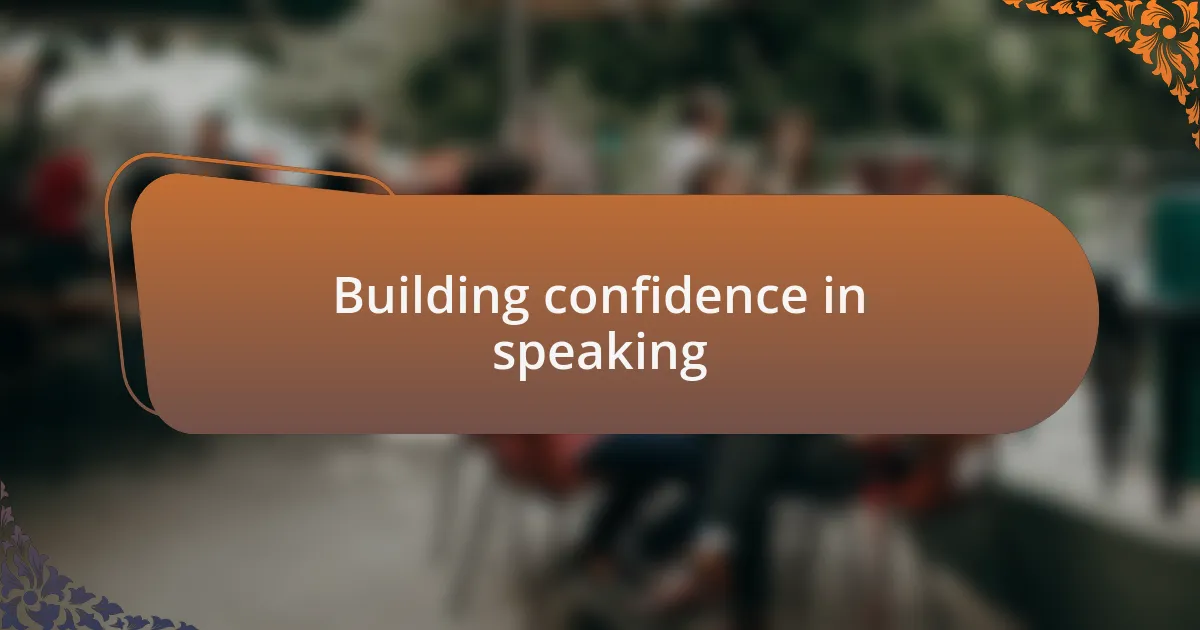
Building confidence in speaking
Building confidence in speaking often starts with small victories. I remember a time when I decided to practice speaking in front of a mirror. At first, it felt awkward and uncomfortable, but as I repeated this exercise daily, I noticed my voice becoming steadier, and my nervousness began to fade. Have you ever tried practicing in front of a mirror? It’s amazing how seeing your own reflection can help build a sense of assurance.
Another powerful way to boost speaking confidence is through positive reinforcement. I once joined a local public speaking group where we celebrated each other’s progress, no matter how small. Sharing my thoughts in a supportive environment where everyone cheered me on made a profound difference. How can you create moments of encouragement in your journey? Positive self-talk and affirmations can also work wonders; I often remind myself of my strengths before speaking up.
Finally, embracing mistakes is crucial in this journey. There was a moment during a presentation when I stumbled over my words, and instead of feeling embarrassed, I chose to laugh it off. I realized that everyone makes mistakes, and they are often far less daunting than they seem in our minds. Can you recall a time when you felt embarrassed about a mistake, only to find it wasn’t as serious as you thought? Recognizing that vulnerability is a part of authentic communication can help you approach speaking with a lighter heart.
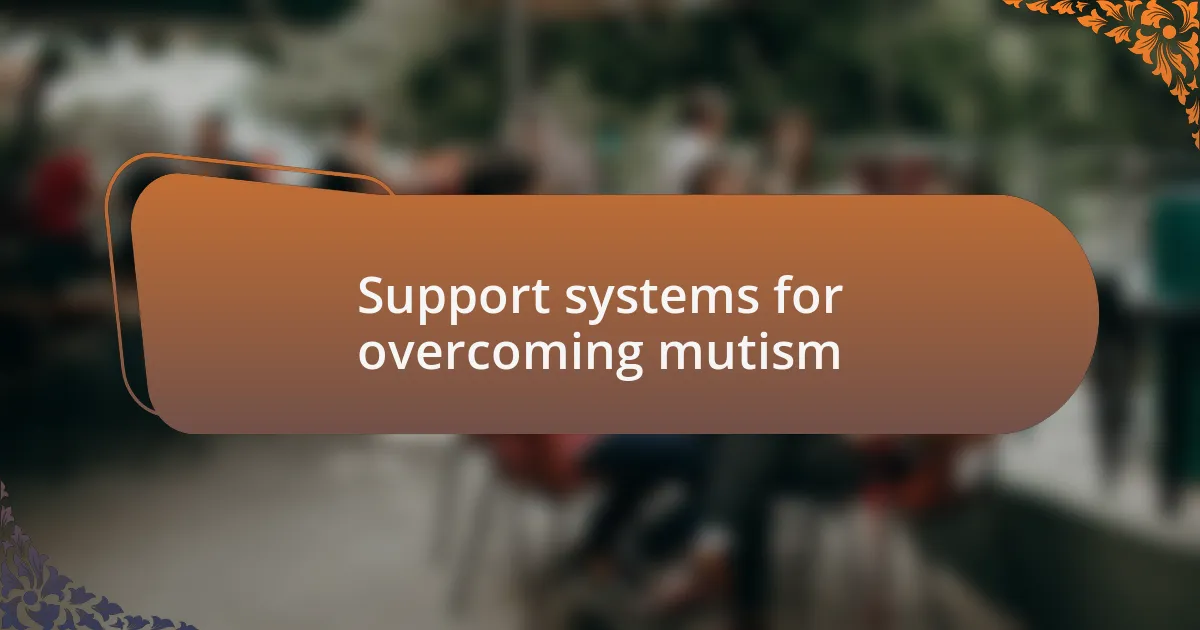
Support systems for overcoming mutism
Support systems play a vital role in overcoming mutism. I remember a time when my family and friends became my anchors. They encouraged me to speak, even if it was just to them, and their constant support helped me to face larger audiences. Have you considered who in your life could provide that type of encouragement?
I found that connecting with others who understand selective mutism was incredibly helpful. When I joined a support group, I felt an overwhelming sense of belonging. Sharing experiences with people who truly get what you’re going through can be incredibly liberating. Have you thought about reaching out to a local group or online community? The shared understanding can turn fear into empowerment.
Additionally, professional support can make a significant difference. Working with a therapist who specializes in anxiety and communication helped me navigate my feelings around speaking. Their strategies, like gradual exposure to speaking situations, provided a structured approach that felt manageable. What have you learned from professionals in your journey, and how have their insights changed your perspective on communication?
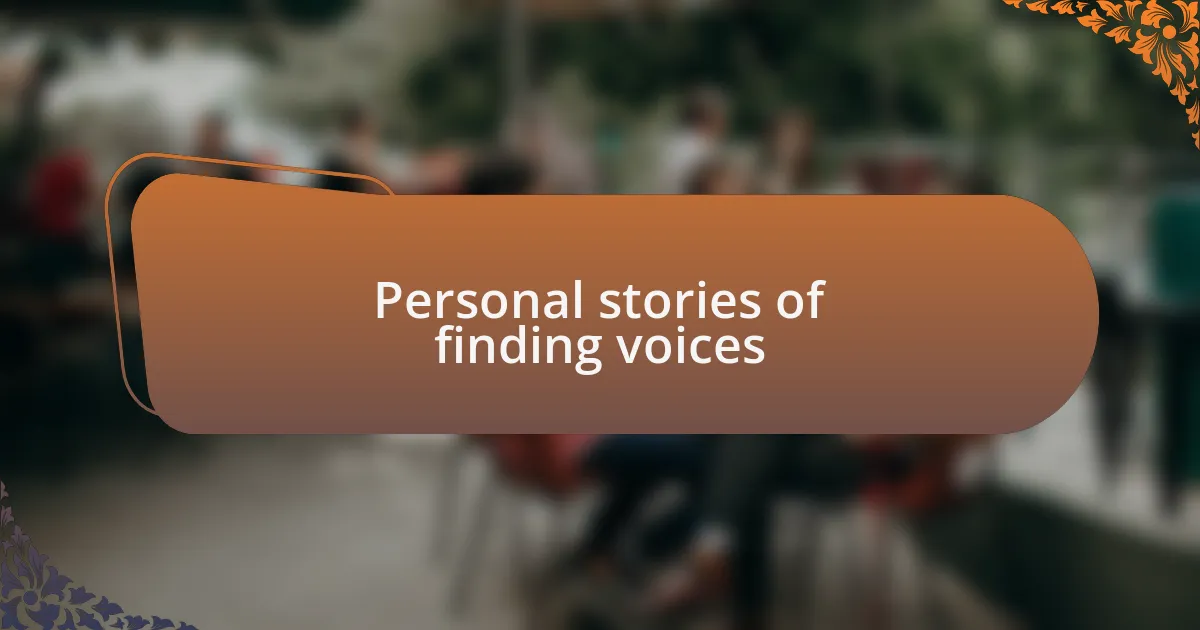
Personal stories of finding voices
Finding my voice was a journey shaped by moments of unexpected courage. I recall sitting in a classroom, heart pounding, as I finally mustered the courage to speak up during a group project. That simple act felt monumental, as I saw my classmates genuinely listen, validating my feelings and ideas. Have you ever experienced that rush of empowerment when you finally share your thoughts?
There was a moment when I was at a family gathering, surrounded by laughter and chatter. I felt an overwhelming urge to join the conversation, but fear held me back. Then, my little cousin, unaware of my struggle, turned to me with wide eyes, asking a question specifically for me. In that instant, I realized that my voice mattered, and with that gentle nudge, I spoke. It was a small triumph, but it taught me that sometimes, all it takes is a little encouragement from others to find the courage to express ourselves.
During my path to speaking out, I often found myself journaling my thoughts. Writing became a safe space for me to articulate feelings I’d struggled to share verbally. I remember one entry where I expressed my desire to connect with others, and I asked myself why I hesitated. This exercise illuminated the fears I held while empowering me to step beyond them. How have your personal reflections helped you uncover your own voice?